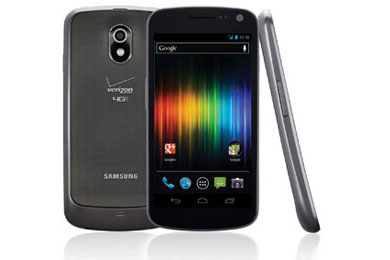
 Released almost a month ago, the Galaxy Nexus smartphone has already been the subject of numerous technical reviews touting the phone’s hits, misses and errors. It’s particularly noteworthy because it is the first to sport the latest (and greatest) Android™ version 4.0, a.k.a. Ice Cream Sandwich (ICS). And frankly it didn’t disappoint, but more about that further on…
Released almost a month ago, the Galaxy Nexus smartphone has already been the subject of numerous technical reviews touting the phone’s hits, misses and errors. It’s particularly noteworthy because it is the first to sport the latest (and greatest) Android™ version 4.0, a.k.a. Ice Cream Sandwich (ICS). And frankly it didn’t disappoint, but more about that further on…
Built by Samsung, the Galaxy Nexus boasts a large 4.65 inch super AMOLED touchscreen with 16M colors that is a joy to behold. Warning—you will have a hard time taking your eyes off of it. The handset is available from Verizon for $299 with a 2-year contract. (Complete specs here.)
Immediately after unwrapping/charging a new phone, the setup is usually a large pain in the ‘processor’. Most users will have email, calendar, task lists, contact lists and numerous social network accounts to orchestrate. A few years ago, this procedure could be so daunting that most consumers needed carrier support when switching hardware. Today the trend for both Android and Apple is to move information into the cloud which simplifies the transfer process immensely. Consequently, I had the Galaxy Nexus completely ready to rock in about 15 minutes, maybe less. My setup secret revolves around adopting Google to run my digital life. With one sign-in account the phone instantly accessed email, Google Plus, Google Reader, Calendar, YouTube, Google Analytics, Adsense and all my contacts. Then I linked my Facebook and Twitter accounts and, Voilá! (Read How Google Seduced Me… for more info.) Android, the phone’s operating system is also Google built, so the uber-compatibility is not an accident.
ICS 4.0 is like a smooth brandy when compared to Froyo (Version 2.2) which is what I had been using on my six-month old, AT&T Samsung Infuse 4G. It’s probably not worth trying to spec every little improvement, but suffice-to-say ICS makes social sharing on Facebook, Twitter, G+ and YouTube simply effortless. The camera worked beautifully. For example, I photographed my car’s shifter, posted it to G+ and within minutes got comments that the image was “brilliant.” Managing memory between open applications is also greatly improved in ICS. The task killer mostly runs by itself, although occasionally I manually exited from a few open apps, more out of habit than necessity. The switchable vibrate function offers a unique tactile sensation when pressing the screen and for alerts that can be adjusted in such detail it almost gives the handset its own user-created unique personality. ICS boasts layers of settings, sounds and vibrations customizable across functions such as calling, keyboard, apps, screen, etc. For the new user, this can take a while to get “just right,” but ultimately it makes the phone more “fun.”
At this moment, Verizon’s Galaxy Nexus is the only way to get Android ICS, but unconfirmed reports now suggest the phone may arrive at Sprint, with an even faster processor. More ICS-equipped phones are undoubtedly in the product pipeline, so if you are budget-minded or waiting for your wireless contract to cycle, be patient. In a few months there should be ample handsets available with this cool 4.0 system.
One complaint which needs to be loudly voiced is the poor performance from Samsung with respect to updates. Last August the company promised Infuse users they would get an update from Froyo to Gingerbread. They renewed the promise in September and again in Oct. It’s now January, and frankly I’ve given up hope. That’s unacceptable. So beware—if you buy a Samsung product, you will likely live out your days with whatever version it ships with.

Face Unlock: Using visual recognition with Galaxy Nexus you can look into the camera to unlock your phone.
Several small-handed reviewers have complained that the Nexus screen was uncomfortably large, or as one guy explained, made it “impossible to use the phone with one hand.” Personally, I love the large screen (4.0 has a customized font which makes reading a breeze.) And why would you want to run the phone with one hand unless you were driving a car, or hanging from a tree? I have nothing against tree hangers, but frankly if you want to use your phone in the car, be in the passenger seat or hook up the bluetooth. Incidentally, the Nexus linked to my car’s console in seconds and I was able to make and receive calls without removing it from my pocket. For me, the large screen is a huge win over iPhone’s stuffy little viewing area, and at almost equal weight (Galaxy Nexus weighs 5.1 oz; iPhone 4.9 oz).
A brief mention about the 4G speed and battery. Being in front of a desktop monitor much of the day I am not a battery drainer. An overnight charge easily lasted until day’s end when I was turning out the lights and plugging back in. Using Ookla’s Speed Test app, the 4G registered a wide range of speeds. At the gym in Green Hills, Nashville, the speed was astounding—almost 36mbps download and 16mbps upload. However at my hilltop home, only a few miles away, speeds were a more conservative, but quite acceptable—12mbps and 6mbps.
Last, but not least is the topic of Google Music. First step was to upload my music files from iTunes to the Google cloud which took almost three days to complete. Fortunately, the desktop Google Music app loaded nicely on my iMac and worked diligently in the background while I accomplished my normal daily tasks. Once uploaded, the music is accessible by phone or desktop. With respect to the Galaxy Nexus I tried streaming music for a hour at a time and it shuffled through quite nicely. The phone has a sophisticated equalizer with a variety of settings allowing it to sync your sonic taste with whatever listening device is in your ears. It really blended beautifully with the Subjekt TNT over-the-ear headphones I enjoy. For heavy music listeners, the 4G bandwidth used by streaming your music could potentially push you over your data limit. Smartly included, however is an option to limit music streaming to wi-fi connections and/or to download songs/albums you designate directly onto the phone’s memory card so they can be listened to offline.
Summary
This phone and the ICS software it runs is slick. It’s an enabler. You’ll find yourself interacting more across various social networks, via email and text simply because you can. All moves flow with no waiting. The pinch/zoom finger motion works nicely in the browser, but not in the email. Like Apple’s OS, I’d like to see that move work everywhere, all the time.
Ice Cream Sandwich is a game-changer, and the hardware which runs it is simply a thing of beauty. My advice, do not buy another Android phone without 4.0. In short, the Galaxy Nexus is a state-of-the-art handset coupled with the leading wireless provider—a powerful combination. This device is far out in front of the smartphone cutting edge at this time, so you can be confident that it should easily stay relevant for a two-year contract period.

About the Author
Journalist, entrepreneur, tech-a-phile, MusicRow magazine founder, lives in Nashville, TN. Twitter him @davidmross or read his non-music industry musings at Secrets Of The ListView Author Profile


